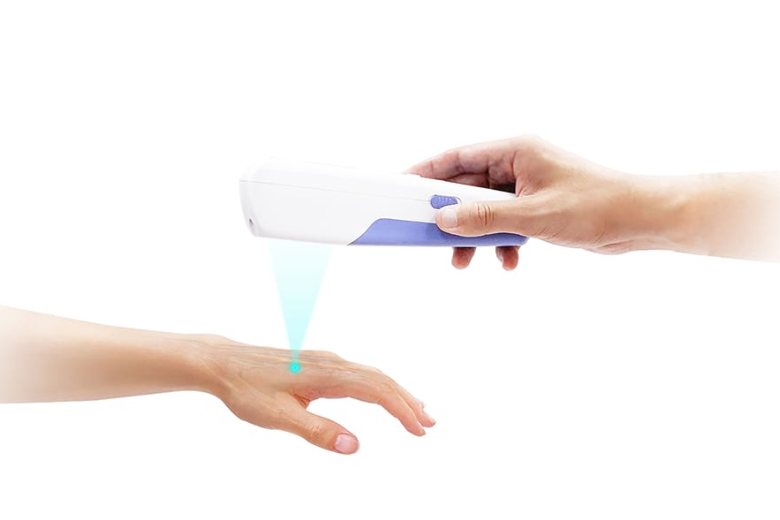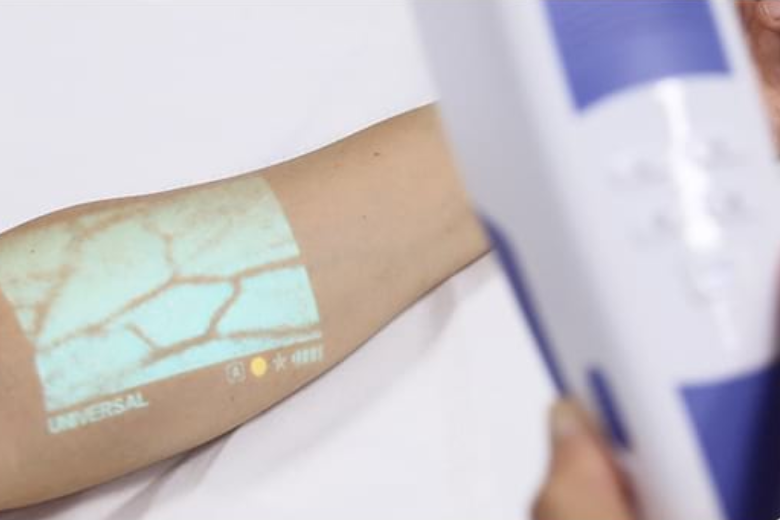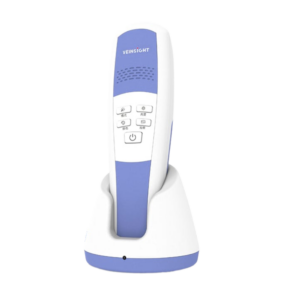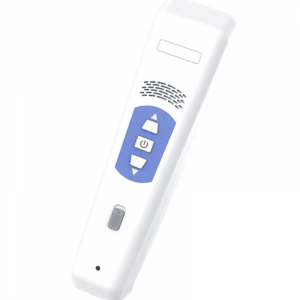Vein Finder technology, also known as Infrared Vein Viewer, Laser Vein Finder, or Vein Illuminator, is an innovative medical technology that utilizes high-frequency light to provide a projected image of the underlying vascular structure on the skin’s surface. Today we are providing a better understanding of Vein Viewer technology, its applications, benefits, clinical studies supporting its use, device features, pricing, and maintenance requirements.
What is a Vein Finder and How is it Used?
A Vein Finder is a medical device that projects a real-time image of a patient’s veins onto their skin’s surface. It helps healthcare professionals locate veins accurately, facilitating procedures such as venipuncture, IV insertion, and blood draws. Vein Viewers use infrared light to detect hemoglobin and capture the vascular pattern beneath the skin. The captured image is then processed and projected onto the patient’s skin, enabling medical practitioners to visualize the veins clearly and make informed decisions.
Vein Viewer technology was first introduced for mainstream healthcare use in the early 2000s. Since then, it has gained widespread adoption and is considered a growing trend in medical facilities worldwide. The increasing demand for improved vein visualization, especially in patients with difficult venous access, has driven the development and refinement of Vein Viewer technology.
Vein Finders belong to the category of medical devices and are often referred to as Infrared Vein Viewers, Laser Vein Finders, or Vein Illuminators. These terms are used interchangeably to describe the technology based on the method it employs to visualize veins. While there may be slight variations in technology, the core purpose of these devices remains the same.

Vein Finder Professional Use & Clinical Procedures
A variety of medical professionals, including nurses, phlebotomists, anesthesiologists, paramedics, and plastic surgeons, utilize Vein Viewer technology in their practice. It proves particularly helpful in procedures involving venipuncture, intravenous catheterization, blood transfusions, and blood draws. Vein Viewers enhance accuracy, minimize discomfort, and reduce the risk of complications associated with accessing veins.

Primary Clinical Benefits
a. Improved First-attempt Success: Vein Finder technology increases the chances of successful vein access on the first attempt, reducing patient discomfort and the need for multiple needle insertions.
b. Time and Cost Savings: By facilitating faster and more accurate vein visualization, Vein Finders contribute to improved workflow efficiency, reducing procedure time and associated costs.
c. Enhanced Patient Safety: Vein Viewer technology reduces the risk of complications, such as extravasation or hematoma formation, by enabling healthcare professionals to identify the most suitable veins for cannulation.
Use in Clinical Healthcare
Venipuncture: Vein viewers assist in locating suitable veins for blood collection, making the process more efficient and reducing discomfort for the patient.
Intravenous (IV) catheter insertion: Vein viewer technology helps healthcare professionals identify optimal veins for successful and accurate IV catheter insertion, reducing the number of attempts and minimizing patient discomfort.
Phlebotomy: Vein viewers aid phlebotomists in locating veins for blood draws, improving the efficiency and success rate of the procedure.
Blood transfusions: Precise vein visualization helps healthcare professionals select appropriate veins for administering blood transfusions, ensuring accurate delivery and reducing the risk of complications.
Intravenous medication administration: Vein viewers assist in identifying suitable veins for administering medications intravenously, ensuring proper placement and minimizing the risk of extravasation.
Chemotherapy: Patients undergoing chemotherapy often have compromised veins. Vein viewers can aid in locating accessible veins, reducing the challenges associated with repeated needle insertions.
Pediatric procedures: Vein viewers are particularly beneficial in pediatric settings, where locating veins can be more challenging due to smaller vessels. They help reduce the stress and discomfort for young patients during venous procedures.
Geriatric care: Aging populations often have fragile or difficult-to-access veins. Vein viewers enable healthcare professionals to visualize veins more clearly, improving the success rate of procedures such as venipuncture and IV catheter insertion.
Dialysis: Vein viewers assist in identifying suitable veins for patients undergoing dialysis, ensuring optimal access for hemodialysis or vascular access procedures.
Anesthesia administration: During pre-operative procedures, vein viewers assist anesthesiologists in locating appropriate veins for the administration of anesthesia, improving efficiency and patient comfort.
Emergency medicine: In emergency situations, quick and accurate vein identification is crucial for timely administration of medication or fluids. Vein viewers can help healthcare professionals locate veins rapidly, even in challenging circumstances.
Use in Plastic & Aesthetic Surgery

Pre-operative assessment: Before performing procedures such as facelifts, blepharoplasty (eyelid surgery), or rhinoplasty, plastic surgeons may use a vein finder/viewer to assess the vascularity and blood supply of the treatment area. This information can aid in surgical planning and minimize the risk of complications related to compromised blood flow.
Facial rejuvenation procedures: Vein finder/viewer devices can assist in locating veins for the administration of dermal fillers or botulinum toxin injections. Precise vein visualization can help avoid vascular injury during injections and reduce the risk of complications, such as intravascular injection or hematoma formation.
Sclerotherapy: Sclerotherapy is a common treatment for varicose veins and spider veins. Vein finder/viewer devices can aid in identifying the veins to be targeted for injection, improving the accuracy and effectiveness of the procedure.
Fat grafting procedures: In procedures like fat grafting or liposuction, a vein finder/viewer can help identify suitable veins for tumescent anesthesia administration or for collecting autologous blood preparations. This assists in optimizing patient comfort and reducing the risk of vascular injury.
Microsurgical procedures: In reconstructive or microsurgical procedures that involve free tissue transfer, a vein finder/viewer can assist in identifying suitable recipient vessels for anastomosis, ensuring adequate blood supply to the transplanted tissue.
Clinical Studies Supporting the Use of Vein Finders
Clinical studies have demonstrated the effectiveness and benefits of Vein Finder technology:
a. Increased First-attempt Success: Several studies have shown a significant increase in first-attempt success rates for peripheral intravenous access when Vein Finder technology is used.
b. Improved Patient Satisfaction: Patients report higher satisfaction levels when Vein Finders are employed due to reduced pain, decreased procedure time, and improved overall experience.
c. Reduced Complications: Studies indicate a decrease in complications associated with venipuncture, such as hematoma formation and infiltration, when Vein Viewer technology is utilized.
Clinical Study References
- Title: Effect of VeinViewer use on first-attempt success rate for peripheral intravenous catheter insertion in difficult-to-access patients Authors: Zhang et al. Published in: The Journal of Vascular Access (2019) Link: Read Study
- Title: Improved intravenous access using near-infrared vascular imaging in critically ill patients Authors: Cho et al. Published in: The Journal of Vascular Access (2018) Link: Read Study
- Title: Effectiveness of vein viewing technology for peripheral venous catheter placement: A systematic review and meta-analysis Authors: Zhang et al. Published in: The Journal of Vascular Nursing (2020) Link: Read Study
Key Features of Vein Finder Devices

Vein Viewer devices on the market offer various features to enhance functionality and usability. While specific features may vary among models, some common key features include:
a. Real-time Vein Projection: Devices provide a real-time image of the patient’s veins, aiding in accurate vein selection.
b. Adjustable Light Intensity: Users can adjust the brightness and contrast levels to optimize vein visualization according to individual patient characteristics.
c. Variable Color Coding: Users can adjust the color hue of the projection to best fit specific room lighting and patient skin color.
d. Portability and Ergonomics: Many devices are lightweight, handheld, and designed for ease of use in different clinical settings.
e. Image Recording and Storage: Advanced Vein Viewers allow capturing and saving images for documentation and reference purposes.
Device Pricing and Determining Quantity for Facility
The price range for Vein Finder devices varies depending on the brand, model, and features offered. Basic low-cost versions can start around a few hundred dollars, while high-end, fully-featured devices can cost several thousand dollars. Determining the number of devices to purchase for a facility depends on factors such as patient volume, department size, and budgetary considerations.
Maintenance Requirements for Vein Finder Devices
To keep Vein Finder devices in good condition and ensure their optimal performance, routine maintenance is necessary. Typical maintenance tasks include:
a. Cleaning: Regular cleaning of the device’s surface and optics to remove dust, dirt, and debris.
b. Calibration: Periodic calibration to maintain accurate vein visualization and alignment of the projection.
c. Software Updates: Updating the device’s software when new versions or improvements are released by the manufacturer.
d. Battery Management: Monitoring battery life and following proper charging protocols to ensure uninterrupted operation.
If You Have Not Yet Utilized It May Be Time to Try
Vein Finder technology has revolutionized vein visualization in healthcare settings, benefiting both medical professionals and patients. Its accurate vein projection, improved success rates, and enhanced patient safety have been supported by clinical studies. With a range of device features available, healthcare facilities can choose a Vein Viewer that best suits their needs and budget. Routine maintenance ensures longevity and optimal performance of these devices, allowing medical professionals to consistently provide high-quality care while minimizing patient discomfort.



